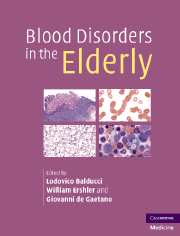Book contents
- Frontmatter
- Contents
- List of contributors
- Preface
- Part I Epidemiology
- Part II Hematopoiesis
- Part III Anemia of aging
- Part IV Hematologic malignancies and aging
- 18 Cancer chemotherapy in the older person
- 19 Acute myeloid leukemia in the elderly
- 20 Acute lymphoblastic leukemia in the elderly patient: diagnosis and therapy
- 21 Multiple myeloma
- 22 Non-Hodgkin lymphoma
- 23 Unusual lymphomas in the elderly
- 24 Chronic lymphocytic leukemia in the elderly
- 25 Polycythemia vera and idiopathic myelofibrosis in the elderly
- Part V Disorders of hemostasis in the elderly
- Index
21 - Multiple myeloma
from Part IV - Hematologic malignancies and aging
Published online by Cambridge University Press: 21 October 2009
- Frontmatter
- Contents
- List of contributors
- Preface
- Part I Epidemiology
- Part II Hematopoiesis
- Part III Anemia of aging
- Part IV Hematologic malignancies and aging
- 18 Cancer chemotherapy in the older person
- 19 Acute myeloid leukemia in the elderly
- 20 Acute lymphoblastic leukemia in the elderly patient: diagnosis and therapy
- 21 Multiple myeloma
- 22 Non-Hodgkin lymphoma
- 23 Unusual lymphomas in the elderly
- 24 Chronic lymphocytic leukemia in the elderly
- 25 Polycythemia vera and idiopathic myelofibrosis in the elderly
- Part V Disorders of hemostasis in the elderly
- Index
Summary
Introduction
Multiple myeloma represents approximately 10% of all hematologic malignancies, and accounts for 1% of all cancers in the USA. It is the second most common hematologic malignancy, and mortality rates from multiple myeloma have increased over the previous three decades. An estimated 15 980 new cases with 11 300 deaths resulting from this disease were expected in 2005. Incidence and prevalence rates are highest among the elderly, men (male : female ratio of 1.1 : 1), African-Americans, and Pacific Islanders. Mortality rates are highest among the elderly and blacks. The median age at diagnosis is 66 years, and the median survival with treatment is approximately three years. Even with conventional treatment using melphalan plus prednisone (MP) or vincristine, doxorubicin plus dexamethasone (VAD) chemotherapy, or high-dose chemotherapy (HDT) followed by stem-cell transplantation, multiple myeloma still remains an incurable disease.
HDT followed by autologous peripheral-blood stem-cell transplants (ASCT) has shown diseasefree and overall survival advantages when compared to standard-dose chemotherapy, but has failed to induce long-term responses in the majority of these patients. Presently, HDT followed by ASCT remains the most effective therapy for treating multiple myeloma with respect to improving disease-free intervals and overall survival, when compared with traditional therapies.
- Type
- Chapter
- Information
- Blood Disorders in the Elderly , pp. 272 - 289Publisher: Cambridge University PressPrint publication year: 2007



